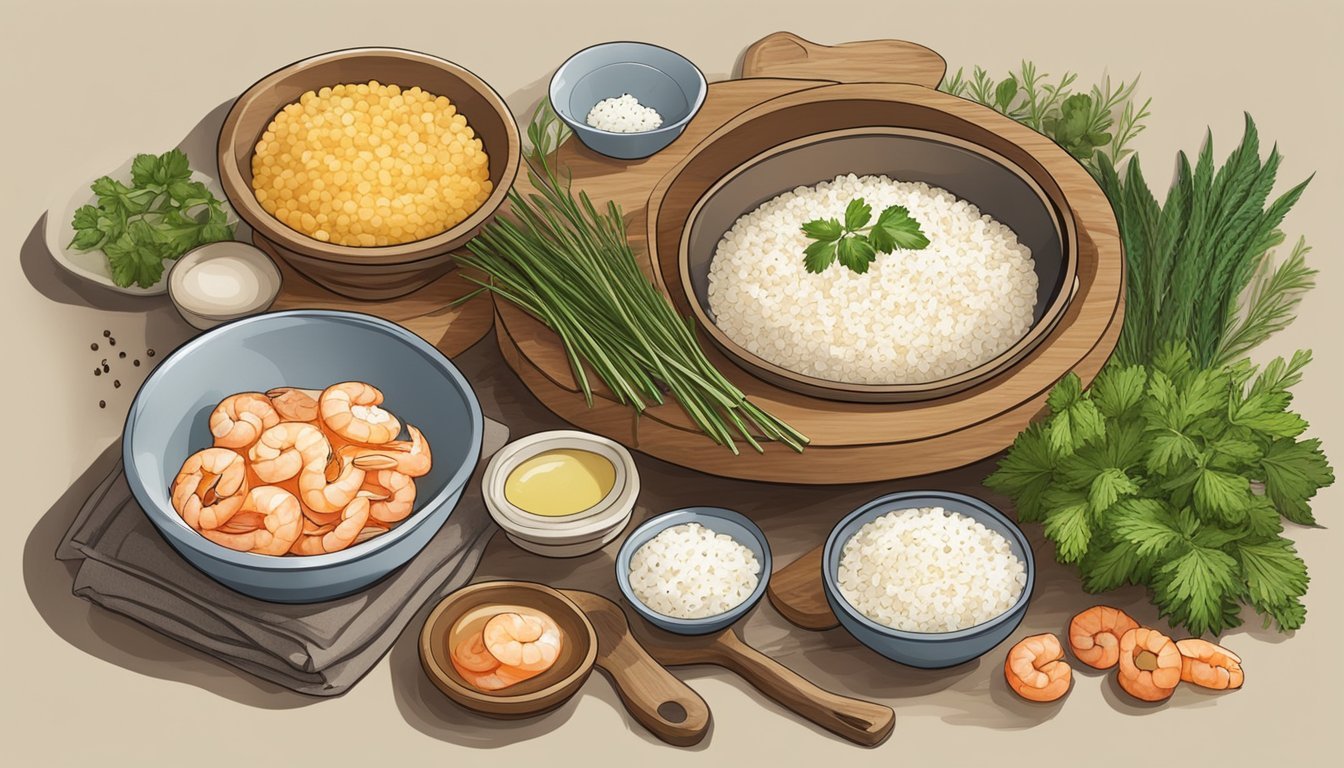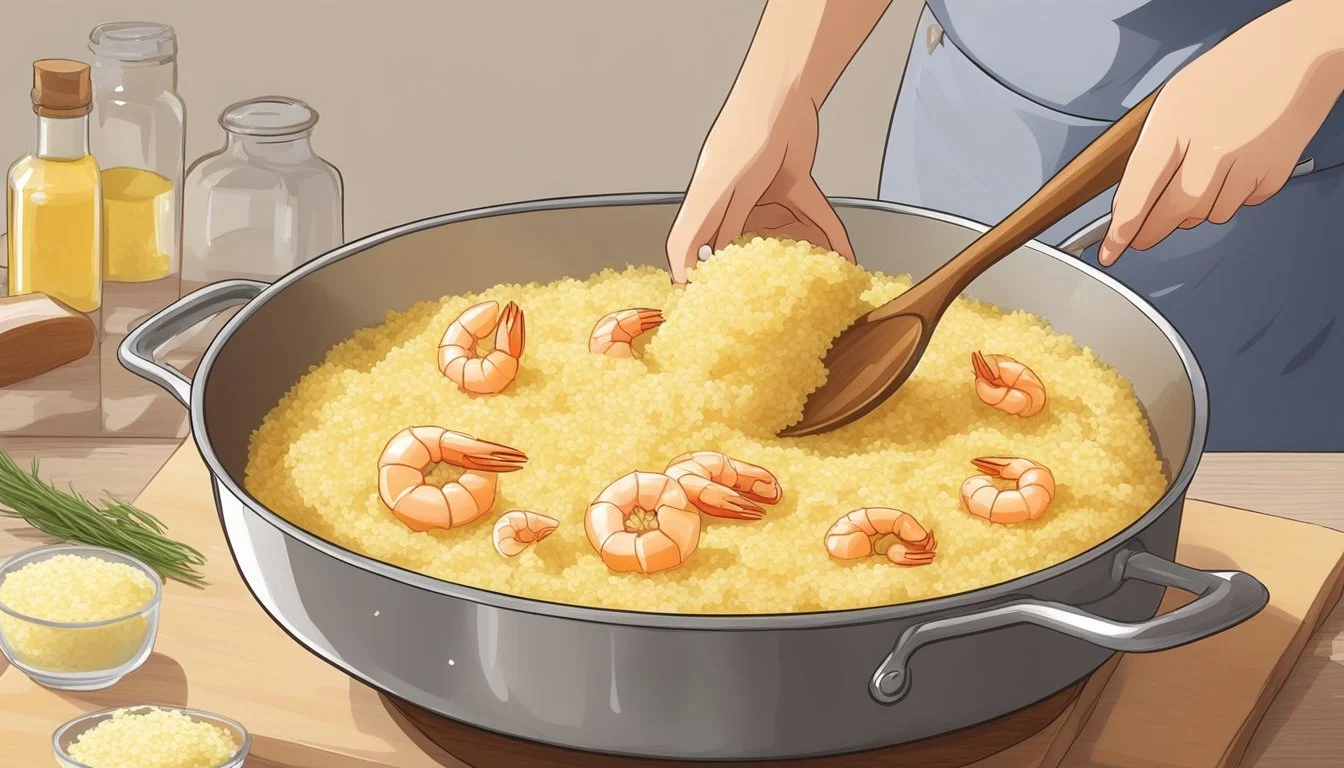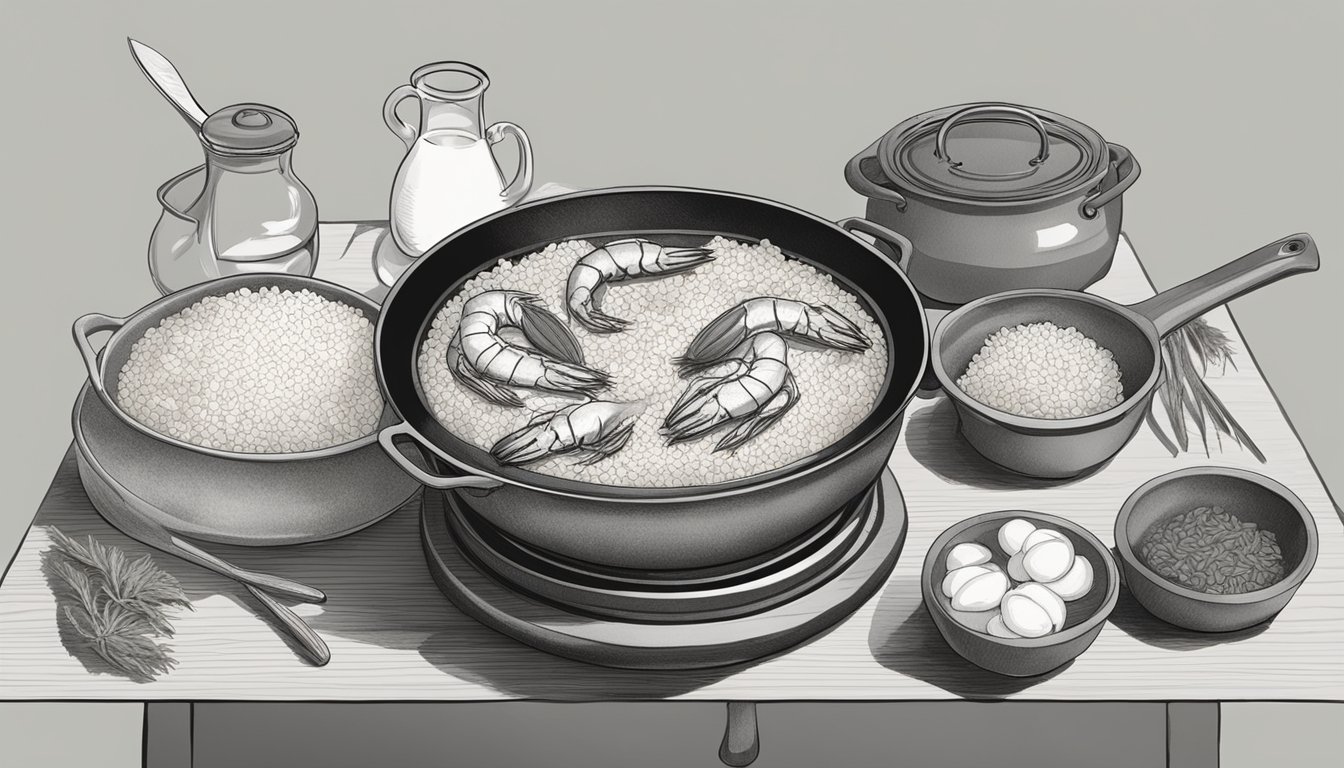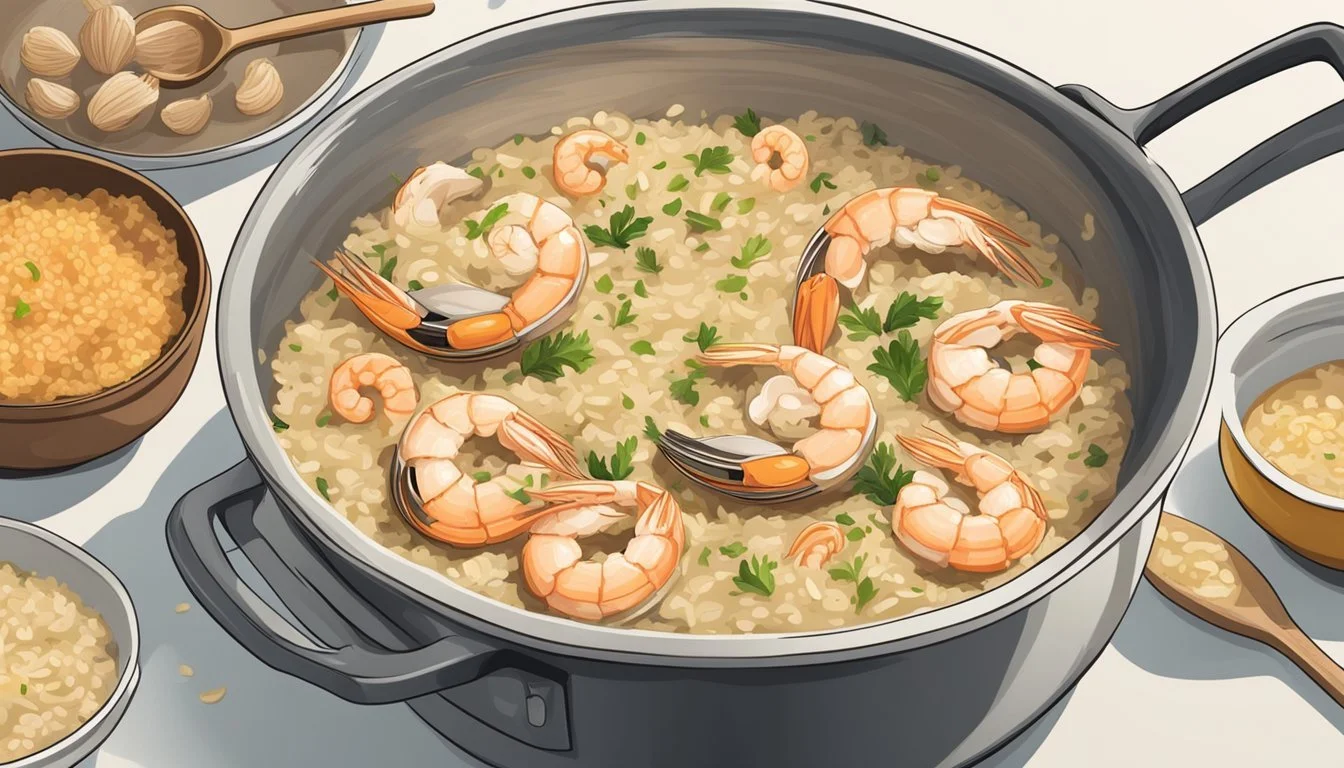How to Make Luxurious Shrimp Head Risotto from Scratch
A Gourmet Guide
Shrimp (What wine goes well with shrimp?) head risotto embodies a luxurious twist on the classic Italian dish, incorporating the rich flavors extracted from shrimp heads to elevate the creamy texture of risotto. Preparing this dish from scratch allows for a symphony of flavors to emerge, as the shrimp heads infuse the oil with a deep, savory essence that serves as the foundation for the rice to absorb. It is an exercise in culinary alchemy, where simple ingredients are transformed into a sumptuous meal that celebrates both the seafood’s freshness and the rice’s comforting starchiness.
To craft such a dish, the process begins with the careful preparation of the shrimp heads and shells. These are sautéed to coax out their vibrant color and intense aroma, setting the stage for layers of flavor that will permeate the risotto. This method not only enhances the taste but also ensures no part of the shrimp is wasted.
As the risotto slowly cooks, careful attention is paid to the addition of stock, allowing each grain of rice to become plump and tender while carrying the essence of the shrimp. A balance of patience and technique results in a risotto that is creamy and rich, with each spoonful encapsulating the opulence of the sea. The dish serves as both a testament to the traditional Italian culinary practice and an ode to the versatility of seafood.
The Essentials of Risotto Making
The mastery of risotto making lies in selecting the appropriate rice and applying precise techniques. Understanding the interaction between ingredients and cooking methods is fundamental to achieving a creamy and luxurious consistency.
Choosing the Right Rice
Risotto requires rice with high starch content and the ability to absorb liquid while maintaining a firm texture. The top choices for risotto rice include:
Arborio rice: Widely available, Arborio rice is known for its creamy texture and good balance of chewiness.
Carnaroli: Preferred by chefs for its superior texture and ability to retain its shape, Carnaroli ensures a creamier risotto than Arborio.
Vialone Nano: Ideal for a looser, more soup-like risotto, Vialone Nano is smaller in grain size and absorbs flavors well.
For the best outcome, these rices should not be rinsed before cooking to preserve their essential starches.
Understanding Risotto Techniques
Key techniques in risotto making feature a combination of patience and attention to detail:
Toasting the Rice: Begin by sautéing the rice in olive oil or butter until each grain is well-coated and slightly translucent. This step, called "tostatura," helps to lock in the rice's natural flavors.
Stirring: Regular but not constant stirring is crucial; it encourages an even cook and releases starches, resulting in a creamier texture.
Stock: The choice of stock is as important as the rice. The stock should be kept at a gentle simmer on a separate burner and added to the rice one ladle at a time, allowing the rice to absorb the stock before adding more.
Warm Broth: Always use warm broth to avoid shocking the rice and slowing down the cooking process. Cold liquids can dramatically affect the consistency of the risotto.
Applying these techniques with careful adherence to timing and temperature will yield a shrimp head risotto that is both luxurious and satisfyingly rich.
Preparing Your Ingredients
To create a luxurious shrimp head risotto, meticulous preparation of ingredients is essential. This ensures a harmonious blend of flavors and textures in the final dish.
Shrimp Preparation
One must begin with the shrimp. For this dish, the freshness of the seafood is paramount. They will need to be peeled, with heads and shells reserved as they are vital for developing a rich seafood stock. The shrimp should be rinsed thoroughly and patted dry before being seasoned. A simple seasoning of kosher salt and black pepper is recommended, and one should set the prepared shrimp aside.
Ingredients for Shrimp Stock:
Reserved shrimp heads and shells
2 cups water or chicken stock (alternative options: vegetable broth or seafood stock)
Vegetable and Herb Prep
Next, the focus shifts to vegetables and herbs. Onion and garlic are diced finely, their flavors integral to the risotto base. Fresh parsley is chopped, set to infuse the dish with its vibrant aroma while lemon zest adds a touch of brightness. For the lemon juice, squeezing fresh gives the best result. The vegetables and herbs will be sautéed in olive oil, adding a subtle fruitiness to the dish.
Ingredients for Sauté:
1 medium onion, finely diced
4 cloves of garlic, minced
1/4 cup chopped parsley
Zest of 1 lemon
One should gather all ingredients before commencing the cooking process to ensure a seamless execution of the subsequent steps.
Starting the Risotto
Making a luxurious shrimp head risotto from scratch involves two crucial steps: sautéing the base to build a flavorful foundation and toasting the rice to prime it for the creamy, al dente finish that risotto is famous for. Paying attention to detail and not rushing this part of the process ensures the success of the dish.
Sautéing the Base
The chef begins by heating 2 tablespoons of olive oil in a large, heavy-bottomed pan. Once hot, they add the finely chopped onion and sauté until it becomes translucent, which typically takes about 2 to 3 minutes. Then, 2 minced garlic cloves are added to the pan. The garlic is stirred frequently, being careful not to let it brown, for about 1 minute to infuse the oil with its aromatic flavor.
Toasting the Rice
Next, 1 cup of Arborio rice is added to the pan, stirring it into the onion and garlic mixture. The rice is toasted for approximately 2 minutes until it's well-coated with oil and slightly translucent around the edges. This is a pivotal step, as toasting helps the rice absorb flavors better and maintain a good texture when cooking. Afterwards, the chef deglazes the pan with ½ cup of dry white wine, such as Pinot Grigio. The mixture should be stirred continuously until the wine is fully absorbed, making sure to scrape any flavorful bits off the bottom of the pan.
Cooking the Risotto
Risotto demands patience and attention to detail. One begins with toasting the rice to unlock a nutty flavor and then gradually incorporates warm broth to achieve a creamy texture.
Adding the Broth
The chef begins by keeping a pot of stock—preferably homemade chicken or vegetable broth—simmering gently on a nearby burner. Once the risotto rice is toasted, they slowly ladle the warm broth into the rice, allowing each addition to be absorbed before adding the next. This process brings out the starch from the rice, which gives risotto its characteristic creaminess.
Begin with one ladle of warm stock, stirring until it's almost fully absorbed.
Repeat the process, maintaining a gentle simmer in the pan, ensuring the rice is always just covered with broth.
The Importance of Constant Stirring
Constant stirring is crucial in risotto preparation, preventing the rice from sticking to the bottom of the pan and ensuring even cooking. Stirring also agitates the grains, releasing starch that contributes to the creamy consistency of the final dish. The chef uses a wooden spoon to stir, incorporating more air and aiding in creaminess.
Stir continually with a wooden spoon.
Furniture moves and agitates rice grains, promoting an even release of starch.
Through these meticulous steps, the rice transforms into a luxuriously creamy risotto with each grain cooked to perfection.
Incorporating the Shrimp
In creating luxurious shrimp head risotto from scratch, it's crucial to properly cook the shrimp to retain its succulence and then integrate it into the rich, creamy risotto to highlight this premium protein.
Cooking the Shrimp
Shrimp should be seasoned tastefully and cooked to perfection. Begin by patting the shrimp dry to ensure even cooking. Season them with 1/2 teaspoon of kosher salt, some lemon juice, and a pinch of garlic powder to enhance their natural flavor. Proceed by heating a generous amount of olive oil or butter in a skillet over medium-high heat. Once hot, carefully add the shrimp and cook for about 1-2 minutes on each side until they just turn opaque and are cooked shrimp but not overcooked. Remember, they will cook further when combined with the risotto.
Ingredients:
Raw shrimp, prepped
1/2 teaspoon kosher salt
Lemon juice (to taste)
Garlic powder (a pinch)
Olive oil or butter for cooking
Combining with Risotto
Once the shrimp are cooked, they should be set aside while you focus on the risotto. Ensure that the risotto is at a creamy consistency before the shrimp are added—this typically comes after the final addition of stock. Return the cooked shrimp to the pan, gently folding them into the risotto to distribute evenly. The residual heat from the risotto will mingle with the tender shrimp, infusing the dish with a rich seafood flavor. Be careful not to overmix, as vigorous stirring could break the delicate shrimp.
Steps:
Cook risotto to a creamy consistency.
Add cooked shrimp to the risotto.
Gently fold in the shrimp and let their flavor meld.
In these steps, both the shrimp and the risotto maintain their integrity, ensuring every spoonful is a harmonious blend of grain and protein.
Final Touches and Seasoning
The final steps in crafting a luxurious shrimp head risotto bring depth of flavor and rich texture. Here, the importance lies in the quality of ingredients and the method of their integration.
Enriching with Butter and Cheese
To elevate the risotto's creaminess, one should stir in cold, unsalted butter immediately after the risotto is removed from heat. A pat of butter, about 2 tablespoons, swirls into the rice, lending a silky consistency and sheen. The cheese is just as pivotal; finely grated Parmesan and Pecorino Romano cheeses, about a half cup in total, meld with the warm risotto. Blend these in slowly to allow for a gradual melt and to prevent clumping. The objective is a harmonious emulsion, which serves to both thicken and enrich the dish.
Butter: 2 tablespoons, unsalted and cold
Cheese: ½ cup, finely grated (blend of Parmesan and Pecorino Romano)
Adding Fresh Herbs
The addition of fresh herbs introduces a bright, aromatic note that contrasts and complements the richness of the butter and cheese. Finely chopped parsley stands out, with its fresh and slightly peppery flavor. Sprinkle a generous tablespoon over the dish just before serving to maintain its vibrant color and to offer a hint of freshness in each bite. A twist of freshly ground black pepper and a pinch of salt, adjusted to taste, can balance and round out the flavors.
Parsley: 1 tablespoon, finely chopped
Black Pepper: freshly ground, to taste
Salt: a pinch, to taste
The careful calibration of these final ingredients is crucial to a luxurious, flavor-packed risotto, ensuring that each spoonful is robust and memorable.
Presentation and Plating
When serving Shrimp Head Risotto, the visual appeal is nearly as important as the flavor. A properly plated dish not only entices the taste buds but also sets the tone for a luxurious dining experience.
Serving Suggestions
One should serve the Shrimp Head Risotto on a warm, neutral-colored plate to accentuate the colors of the dish. It is recommended to allocate a generous portion in the center, using a ladle to maintain a mound shape which suggests abundance and allows the risotto to keep its temperature. If one has cooked the heads and shells to create a stock, they might set aside some of the most attractive heads, and after a gentle heat, place them atop the risotto as a nod to the dish's foundation.
Garnishing for Flair
To add a touch of refinement, one may garnish with chopped parsley for a fresh, herbal note and a pop of green color. A sprinkle of lemon zest can introduce a bright, citrus scent, hinting at the underlying flavors within the risotto. Finally, a light dusting of freshly cracked pepper can add both visual contrast and a subtle heat. For an extra touch of elegance, one may add thin lemon slices as an edible decoration that complements the shrimp's flavor.
Pairing and Accompaniments
The right wine pairing and side dishes can transform shrimp head risotto into a complete gastronomic experience. One should consider the intensity of the risotto's flavor and the texture of the shrimp when selecting these.
Wine Pairing
When it comes to wine, dry white wines are an exemplary choice for shrimp head risotto. Specifically, a well-chilled Pinot Grigio complements the dish with its light body and crisp finish, balancing the richness of the risotto without overwhelming the delicate taste of shrimp.
Recommended Wine: Pinot Grigio
Characteristics: Light-bodied, crisp, with citrus notes
Temperature: Serve chilled
Side Dishes
The risotto should be the star, so side dishes are best kept simple yet fresh. Some of the finest options include:
Asparagus: Its vibrant green hue and slight bitterness make grilled or steamed asparagus an ideal counterpoint.
Preparation: Grilled with olive oil and sea salt
Serving: Next to the risotto or chopped and mixed in
Broccoli: Roasted broccoli, seasoned with garlic, adds a crunchy texture and earthy flavors.
Preparation: Roasted with garlic and pepper
Serving: As a separate side dish
Green Salad: A simple green salad dressed with vinaigrette cleanses the palate between bites of creamy risotto.
Ingredients: Mixed greens, cherry tomatoes, light vinaigrette
Serving: In a separate salad bowl before or alongside risotto
The accompanying dishes and wine should complement the risotto's creamy texture and the rich flavor imparted by shrimp heads, creating a well-rounded dining experience.
Shrimp Risotto Variations
Creating a luxurious shrimp head risotto allows for a plethora of variations to suit different tastes and occasions. Experimentation can lead to a dish that is not only hearty and comforting but also rich in flavors and textures.
Adding Vegetables
Incorporating vegetables into shrimp risotto can elevate the dish with added nutrients and a burst of color. Mushrooms are a classic choice, imparting an umami flavor that complements the creamy texture of the risotto. One can sauté a variety of mushrooms such as cremini or shiitake before folding them into the risotto. Spinach is another excellent addition, offering a subtle earthiness and enhancing the risotto's visual appeal. It can be stirred in right at the end, as its delicate leaves wilt quickly with the residual heat.
Mushrooms:
Sauté before adding
Add depth to flavor
Spinach:
Stir in at the end
Enhances visual appeal
Alternative Proteins
While shrimp is the star protein in the dish, one can consider alternative proteins to diversify the risotto's profile. Lobster (What wine goes well with lobster?) can bring a luxurious twist to the risotto, making it suitable for special occasions. The creamy texture of the risotto becomes a perfect backdrop for the lobster’s rich and tender flesh. A variety of other seafood or even chicken can be used to adapt the risotto for different dietary preferences or to simply enjoy a variation on a classic weeknight dinner.
Lobster:
Adds a touch of luxury
Complements creamy texture
Other Proteins:
Seafood varieties or chicken
Adapt for preferences or variety
Storing and Reheating Risotto
Properly storing and reheating risotto is essential to maintain its luxurious texture and flavor. Below are specific guidelines to ensure your shrimp head risotto remains as delightful as when initially served.
Proper Storage
Refrigerator: The risotto should be transferred to an airtight container and refrigerated within two hours of cooking to prevent bacterial growth. It will retain its quality for 2-3 days. Do not leave risotto at room temperature for extended periods.
Freezer: For longer storage, risotto can be frozen. However, texture may be affected since the thawing process can break down the starches that give risotto its creaminess. To freeze, one should:
Allow the risotto to cool completely.
Portion the risotto into airtight containers or freezer bags.
Label with the date and freeze for up to one month.
Reheating Instructions
Microwave: Place the risotto in a microwave-safe dish, add a splash of chicken or vegetable broth to revive creaminess and cover. Heat in 30-second increments, stirring occasionally, until thoroughly warmed.
Stovetop:
Pour the risotto into a pan.
Add a small amount of broth or water to restore moisture.
Reheat over medium-low heat, stirring frequently to avoid sticking and ensure even heating.
In both methods, one should be cautious not to overheat as this can cause the shrimp to become tough and the risotto to lose its creamy consistency. If the risotto had been frozen, it should be defrosted in the refrigerator overnight before reheating.
Additional Tips and Tricks
To achieve restaurant-quality risotto that boasts a creamy consistency and perfectly al dente rice, one must be vigilant in the cooking process. The following tips are essential for mastering this luxurious Italian dish, making it not only achievable for a weekend project but also accessible for weeknight meals.
Cooking Risotto Al Dente
Stir Constantly: Regular stirring encourages the rice to release its starch, adding to the risotto's creaminess. However, one should refrain from over-stirring to avoid rice becoming too mushy.
Heat Control: Maintain a gentle simmer throughout cooking. This ensures even absorption of liquid, crucial for achieving al dente rice with just the right bite.
Tasting Frequently: Test the rice for texture starting at 18 minutes. It should be tender with a slight firmness in the center.
Exploring More Risotto Recipes
Ingredient Variations: Experiment with different broths and fresh herbs to subtly change the flavor profile of your risotto.
Incessant Evolvement: Evolve the basic risotto recipe by incorporating seasonal vegetables, quality proteins, or unique spices.
Keep Instructions Handy: For consistency, keep tried-and-true instructions as a base when trying new recipes, making small adjustments to accommodate new ingredients.
By adhering to these specific methods, one can create a sumptuous shrimp head risotto with confidence, clarity, and Italian flair.
Frequently Asked Questions
What is the best way to make shrimp head risotto gluten-free?
One can use Arborio rice, which is naturally gluten-free, to make shrimp head risotto. It is important to ensure that all other ingredients, such as stock or wine, are certified gluten-free products.
Can leftover risotto be stored and reheated?
Yes, leftover risotto can be stored in an airtight container in the refrigerator for up to two days. For reheating, add a bit of water or stock to prevent drying out, and warm it up slowly on the stove-top, stirring gently.
Should shrimp shells be used in the risotto?
Indeed, shrimp shells are packed with flavor and can be simmered to make a rich, savory stock that serves as the base of the risotto. After simmering, one needs to strain and discard the shells.
Is making shrimp head risotto considered healthy?
Risotto can be a healthy dish if prepared with a mindful approach to ingredients. Use a moderate amount of healthy fats, such as olive oil, and load the risotto with vegetables to enhance its nutritional profile.
Storage Tips Details Refrigeration Store in airtight container; lasts up to 48 hours Reheating Add liquid, reheat gently; stir to maintain creaminess Freezing (not recommended) Can become grainy and lose texture
Where is the best place to buy ingredients for shrimp head risotto?
One can find high-quality ingredients for shrimp head risotto at gourmet food stores, seafood markets for fresh shrimp, or at local grocery stores with a well-stocked international aisle for Arborio rice and other essentials.









